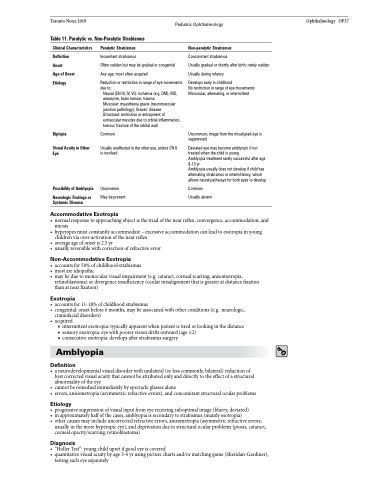Page 927 - TNFlipTest
P. 927
Toronto Notes 2019
Pediatric Ophthalmology
Ophthalmology OP37
Table 11. Paralytic vs. Non-Paralytic Strabismus
Clinical Characteristics
Definition Onset
Age of Onset Etiology
Diplopia
Visual Acuity in Other Eye
Possibility of Amblyopia
Neurologic Findings or Systemic Disease
Paralytic Strabismus
Incomitant strabismus
Often sudden but may be gradual or congenital
Any age; most often acquired
Reduction or restriction in range of eye movements due to:
Neural (CN III, IV, VI): ischemia (e.g. DM), MS, aneurysm, brain tumour, trauma
Muscular: myasthenia gravis (neuromuscular junction pathology), Graves’ disease
Structural: restriction or entrapment of extraocular muscles due to orbital inflammation, tumour, fracture of the orbital wall
Common
Usually unaffected in the other eye, unless CN II is involved
Uncommon May be present
Non-paralytic Strabismus
Concomitant strabismus
Usually gradual or shortly after birth; rarely sudden Usually during infancy
Develops early in childhood
No restriction in range of eye movements Monocular, alternating, or intermittent
Uncommon; image from the misaligned eye is suppressed
Deviated eye may become amblyopic if not treated when the child is young
Amblyopia treatment rarely successful after age 8-10 yr
Amblyopia usually does not develop if child has alternating strabismus or intermittency, which allows neural pathways for both eyes to develop
Common Usually absent
Accommodative Esotropia
• normalresponsetoapproachingobjectisthetriadofthenearreflex:convergence,accommodation,and miosis
• hyperopesmustconstantlyaccommodate–excessiveaccommodationcanleadtoesotropiainyoung children via over-activation of the near reflex
• averageageofonsetis2.5yr
• usuallyreversiblewithcorrectionofrefractiveerror
Non-Accommodative Esotropia
• accountsfor50%ofchildhoodstrabismus
• mostareidiopathic
• maybeduetomonocularvisualimpairment(e.g.cataract,cornealscarring,anisometropia,
retinoblastoma) or divergence insufficiency (ocular misalignment that is greater at distance fixation than at near fixation)
Exotropia
• accountsfor11-18%ofchildhoodstrabismus
• congenital: onset before 6 months, may be associated with other conditions (e.g. neurologic,
craniofacial disorders)
• acquired
■ intermittent exotropia: typically apparent when patient is tired or looking in the distance ■ sensory exotropia: eye with poorer vision drifts outward (age ≥2)
■ consecutive exotropia: develops after strabismus surgery
Amblyopia
Definition
• aneurodevelopmentalvisualdisorderwithunilateral(orlesscommonly,bilateral)reductionof best corrected visual acuity that cannot be attributed only and directly to the effect of a structural abnormality of the eye
• cannotberemediedimmediatelybyspectacleglassesalone
• errors,anisometropia(asymmetricrefractiveerrors),andconcomitantstructuralocularproblems
Etiology
• progressivesuppressionofvisualinputfromeyereceivingsuboptimalimage(blurry,deviated)
• inapproximatelyhalfofthecases,amblyopiaissecondarytostrabismus(mainlyesotropia)
• othercausesmayincludeuncorrectedrefractiveerrors,anisometropia(asymmetricrefractiveerrors,
usually in the more hyperopic eye), and deprivation due to structural ocular problems (ptosis, cataract, corneal opacity/scarring, retinoblastoma)
Diagnosis
• “HollerTest”:youngchildupsetifgoodeyeiscovered
• quantitativevisualacuitybyage3-4yrusingpicturechartsand/ormatchinggame(Sheridan-Gardiner),
testing each eye separately


